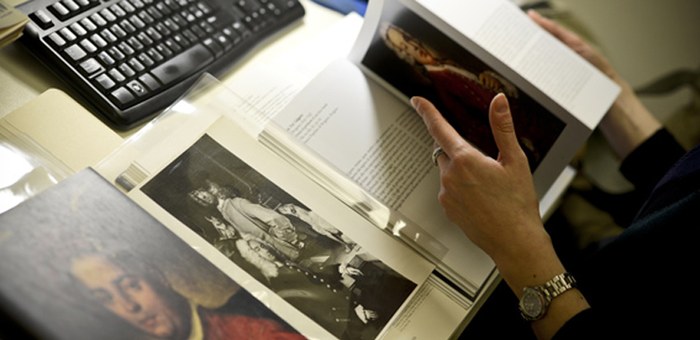Cataloguing and digitizing the Zeri Photo Archive led to creation of a rich database today considered the most important repertoire of Italian art on the web. The computerized cataloguing project conceived by the Foundation workgroup formed of art historians, archivists, curators, librarians, has been recently extended to the new collections acquired by the Foundation.
The conservation and enhancement project of Federico Zeri's Photo Archive took place on the basis of international archival and cataloguing standards and involved the following phases:
- Inventorying the photo collection.
- Monitoring the state of conservation and securing of materials.
- Planning a cataloguing system based on the typology and organization of the photo archive, following the ICCD (Central Institute for Cataloging and Documentation) standards.
- Defining digitizing parameters.
- Creating a specific software for cataloguing and an online consultation interface.
INVENTORYING
The photo archive came in one block without being rearanged after Zeri's death.
An inventory of the collection contents at the time of donation was drawn up. It follows Zeri's criteria and provides an immediate hierarchical map of the archive as a whole.
An inventory of the collection contents at the time of donation was drawn up. It follows Zeri's criteria and provides an immediate hierarchical map of the archive as a whole.
All the iconographic material was stamped and inventoried with a univocal, progressive number fixing Zeri's original order of photographs inside folders.
CONSERVATION
Compiling the inventory has brought to light the original photos' state of conservation. Photographic proceedings within the archive were identified, and photographs selected for restoration. At the same time, a system for conditioning the materials was developed. The original boxes were substituted with containers compliant with international standards for photographic material (ISO 10214). Every photograph was placed in polypropylene bag, protecting it from further damage caused by handling.
Starting in 2009 a restoration campaign was conducted on the precious nucleus of large format photographs, consisting mainly of carbon and albumin prints dating back to the end of the 19th and beginning of the 20th centuries.
CATALOGUING
The cataloguing system entailes compiling two connected fact-sheets: an Artwork entry and a Photograph entry. The first one gives information about the work of art depicted, deduced primarily from Zeri's annotations on the back of the photo, as well as from the attached documentation and volumes found in the library. The second, conforming to ICCD F standards inventory level, contains information referring to the photographic object.
DIGITIZATION
The project aimed at digital acquisition of all the photographic material.
Photographs, whether black and white or in color, were scanned in a 24-bit RGB colour space and saved as files in TIFF format, measuring 3072 pixels on the longest side, as per national ICCD standards. The TIFF files incorporated technical metadata tracing the image's history, including any control and optimization effects made with Adobe Photoshop. From these digital matrixes, archived on HDD and DVD,high and low resolutions jpg formats were extracted respectively linked to rthe internet and intranet files.
In the case of photographs featuring written annotations on the back, the backs have likewise been digitized.
The DVD used by the Federico Zeri Foundation for long term storage of the Italian Painting section images (DVD FalconMedia, Museum/gold), are manufactured by Falcon Technologies International L.L.C.
CONSULTING THE ONLINE CATALOGUE
The digital catalogue permits immediate and rapid search for all artworks and photographs in the database. Three search levels, free, simple and advanced, are available for both photograph and artwork fact-sheets.
The same catalogue is open for consultation via intranet at the computer stations available in the Federico Zeri Foundation, allowing visualization of high resolution images in jpg format as well as the backs of photographs. It is also possible to consult specific fields relating to the photograph data not available online.
